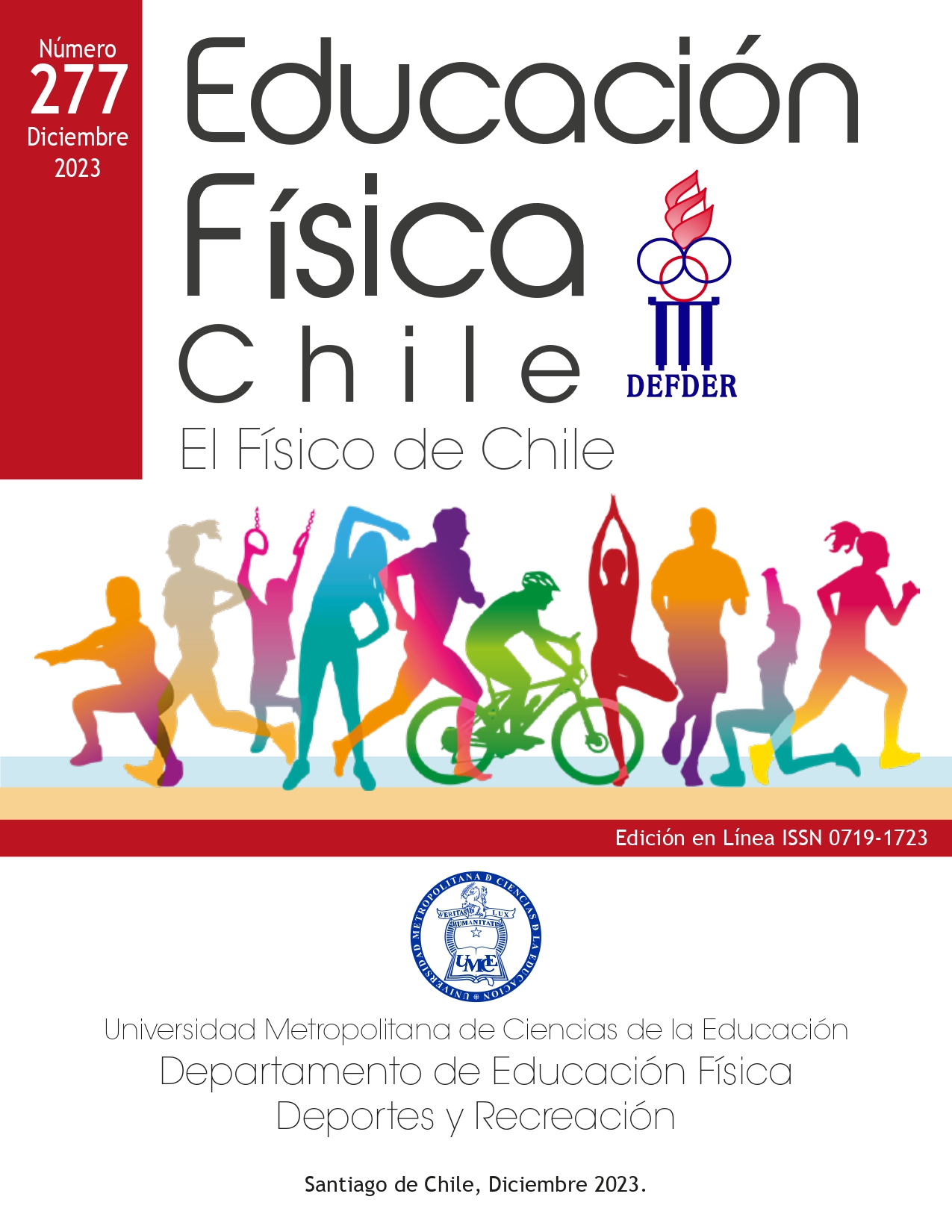Contenido principal del artículo
dic 4, 2023
Resumen
El salto está condicionado por diferentes factores, entre ellos, factores antropométricos y biomecánicos. El propósito de esta investigación es determinar la correlación entre el índice de fuerza reactiva (IFR) y la circunferencia de pantorrilla (CP) en jugadoras universitarias de voleibol. La muestra estuvo compuesta por 29 deportistas, se realizó la prueba de saltos repetidos con plataforma de contacto y se midió el CP. La correlación entre el CP y las variables biomecánicas se determinó mediante la prueba de Spearman. No se encontraron correlaciones significativas entre el CP y el IFR o la altura de salto. Los resultados de este estudio permiten reconocer que el CP no es un indicador directo de capacidad reactiva o altura de salto vertical.
Citas
Ashwini, K. (2015). A study on relationship between calf muscle girth and and vertical jump ability. International Journal of Physiology, Nutrition and Physical Education, 3(1), 362–363.
Bosco, C. (1994). La valoración de la fuerza con el test de Bosco (J. Padulles, Ed.; Vol. 1). Editorial Paidotribo.
Comyns, T. M., Harrison, A. J., & Hennessy, L. K. (2011). An investigation into the recovery process of a maximum stretch-shortening cycle fatigue protocol on drop and rebound jumps. Journal of Strength and Conditioning Research, 25(8), 2177–2184.
De Blas Foix, X., Padullés, J., & González-Gómez, J. (2012). Proyecto Chronojump: Sistema de Medida y Gestión de la Capacidad de Salto usando Software y Hardware Libres. Revista Internacional de Ciencias Del Deporte, 8(30), 334–356.
Díaz, G., Vera, O., & Contreras, D. (2006). Análisis del índice de elasticidad y fuerza reactiva, bajo el concepto de longitudes y masas segmentales de los miembros inferiores. Lecturas: Educación Física y Deportes, 96. https://www.efdeportes.com/efd96/masas.htm
Fattahi, A., Ameli, M., Sadeghi, H., & Mahmoodi, B. (2012). Relationship between anthropometric parameters with vertical jump in male elite volleyball players due to game’s position. Journal of Human Sport and Exercise, 7(3), 714–726. https://doi.org/10.4100/jhse.2012.73.11
García-López, J. G. ; (2003). Test de salto vertical: Aspectos funcionales. Rendimiento, 6, 1–14. http://www.rendimientodeportivo.com/N006/artic029.htm
Gervasi, M., Benelli, P., Venerandi, R., & Fernández-Peña, E. (2022). Relationship between Muscle-Tendon Stiffness and Drop Jump Performance in Young Male Basketball Players during Developmental Stages. International Journal of Environmental Research and Public Health, 19(24). https://doi.org/10.3390/ijerph192417017
Healy, R., Kenny, I. C., & Harrison, A. J. (2016). Assessing reactive strength measures in jumping and hopping using the optojumpTM system. Journal of Human Kinetics, 54(1), 23–32. https://doi.org/10.1515/hukin-2016-0032
Healy, R., Kenny, I. C., & Harrison, A. J. (2018). Reactive strength index: A poor indicator of reactive strength? International Journal of Sports Physiology and Performance, 13(6), 802–809. https://doi.org/10.1123/ijspp.2017-0511
Hernández, R., Fernández, C., & Baptista, M. del P. (2014). Metodología de la Investigación. McGraw-Hill Interamericana.
Hiikkinen, K., & Keskinen, K. L. (1989). Muscle cross-sectional area and voluntary force production characteristics in elite strength-and endurance-trained athletes and sprinters. In Applied Journal of Physiology and Occupational Physiology (Vol. 59). Springer-Verlag.
Kabacinski, J., Szozda, P. M., Mackala, K., Murawa, M., Rzepnicka, A., Szewczyk, P., & Dworak, L. B. (2022). Relationship between Isokinetic Knee Strength and Speed, Agility, and Explosive Power in Elite Soccer Players. International Journal of Environmental Research and Public Health, 19(2). https://doi.org/10.3390/ijerph19020671
Kubo, K., Kawakami, Y., & Fukunaga, T. (1999). Influence of elastic properties of tendon structures on jump performance in humans. Journal of Applied Physiology, 87(6), 2090–2096. http://www.jap.org
Lima, R. F., Palao, J. M., & Clemente, F. M. (2019). Jump Performance During Official Matches in Elite Volleyball Players: A Pilot Study. Journal of Human Kinetics, 67(1), 259–269. https://doi.org/10.2478/hukin-2018-0080
Marshall, B. M., & Moran, K. A. (2015). Biomechanical Factors Associated With Jump Height A Comparison of Cross-Sectional and Pre-to-Posttraining Change Findings. Journal of Strength and Conditioning Research, 29(12), 3292–3299.
McKay, A. K. A., Stellingwerff, T., Smith, E. S., Martin, D. T., Mujika, I., Goosey-Tolfrey, V. L., Sheppard, J., & Burke, L. M. (2022). Defining Training and Performance Caliber: A Participant Classification Framework. International Journal of Sports Physiology and Performance, 17(2), 317–331. https://doi.org/10.1123/ijspp.2021-0451
McMahon, J. J., Comfort, P., & Pearson, S. (2012). Lower Limb Stiffness: Effect on Performance and Training Considerations. Strength & Conditioning Journal, 34(6), 94–101. https://doi.org/10.1519/SSC.0b013e3182781b4e
Mielgo-Ayuso, J., Calleja-González, J., Clemente-Suárez, V. J., & Zourdos, M. C. (2015). Influence of anthropometric profile on physical performance in elite female volleyballers in relation to playing position. Nutricion Hospitalaria, 31(2), 849–857. https://doi.org/10.3305/nh.2015.31.2.7658
Mohemed, S., Pais, V., Afshan, S., Shemjaz, A., & Pais, S. (2015). Relationship of limb girth, segmental limb length, hamstring flexibility with vertical jump in male sports players. International Journal of Current Research and Review, 7, 72–75. https://www.researchgate.net/publication/272678441
Nikolaidis, P. T., Gkoudas, K., Afonso, J., Clementesuarez, V. J., Knechtle, B., Kasabalis, S., Kasabalis, A., Douda, H., Tokmakidis, S., & Torres-Luque, G. (2017). Who jumps the highest? Anthropometric and physiological correlations of vertical jump in youth elite female volleyball players. Journal of Sports Medicine and Physical Fitness, 57(6), 802–810. https://doi.org/10.23736/S0022-4707.16.06298-8
Norton, K. I. (2019). Standards for Anthropometry Assessment. In Kinanthropometry and Exercise Physiology (pp. 68–137). Routledge. https://doi.org/10.4324/9781315385662-4
Pleša, J., Kozinc, Ž., Smajla, D., & Šarabon, N. (2022). The association between reactive strength index and reactive strength index modified with approach jump performance. PLoS ONE, 17(2 February). https://doi.org/10.1371/journal.pone.0264144
Pueo, B., Penichet-Tomas, A., & Jimenez-Olmedo, J. M. (2020). Reliability and validity of the Chronojump open-source jump mat system. Biology of Sport, 37(3), 255–259. https://doi.org/10.5114/biolsport.2020.95636
Ramirez-Campillo, R., García-Pinillos, F., Nikolaidis, P. T., Clemente, F. M., Gentil, P., & García-Hermoso, A. (2022). Body composition adaptations to lower-body plyometric training: A systematic review and meta-analysis. Biology of Sport, 39(2), 273–287. https://doi.org/10.5114/BIOLSPORT.2022.104916
Sattler, T., Sekulic, D., Hadzic, V., Uljevic, O., & Dervisevic, E. (2012). Vertical jumping tests in volleyball: reliability, validity, and playing-position specifics. Journal of Strength and Conditioning Research, 26(6), 1532–1538.
Young, W. (1995). Laboratory strength assessment of athletes. New Studies in Athletics, 10(1), 89–96.



